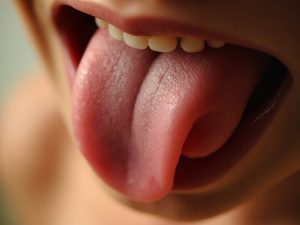Table of Contents
TogglePrinciples of Tongue Diagnosis in Traditional Chinese Medicine: The Zang-Fu Organ Mapping on the Tongue Surface
Author: Gu Yuxi Editor: Gu Yuxi Translator: Gu Yuxi
Principles of Tongue Diagnosis (2): The Zang-Fu Organ Mapping on the Tongue Surface
Pathological changes in the Zang-Fu organs are reflected on the tongue surface, exhibiting a certain pattern of distribution. Ancient medical texts record different divisions of this mapping, with three main methods of categorization.
Dividing According to the Five Zang Organs
Different schools of thought vary slightly, but a relatively consistent view is that the tongue tip corresponds to the Heart and Lungs, the tongue sides to the Liver and Gallbladder, the tongue center to the Spleen and Stomach, and the tongue root to the Kidneys (as shown in the diagram below).

Dividing According to the Stomach Meridian
The tongue tip corresponds to the upper Jiao (upper warmer), the tongue center to the middle Jiao (middle warmer), and the tongue root to the lower Jiao (lower warmer). This method is suitable for the diagnosis of Stomach diseases.
Dividing According to the Three Jiao
The tongue tip corresponds to the upper Jiao (Heart and Lungs), the tongue center to the middle Jiao (Spleen and Stomach), and the tongue root to the lower Jiao (Liver and Kidneys). This method is suitable for the diagnosis of febrile diseases.
The aforementioned theories regarding the distribution on the tongue surface illustrate that visceral lesions have certain patterns in terms of changes in the tongue appearance. These are summaries of clinical experience from physicians throughout history and have certain reference value. However, one should not be overly rigid or dogmatic, but rather integrate tongue diagnosis with the other four diagnostic methods and comprehensively analyze the findings along with other systemic symptoms.
— Excerpt from Li Candong’s Diagnostics of Traditional Chinese Medicine
My Annotations and Analysis:
Concise Diagram of Zang-Fu Organ Mapping on the Tongue Surface
Three Theories of Tongue Surface Localization
1. Five Zang Organ Localization Method (General Diagnostic Method)
Tongue tip → Heart, Lungs (e.g., redness at the tongue tip often indicates heat syndrome in the Heart and Lungs)
Tongue sides → Liver, Gallbladder (teeth marks on the tongue edges often suggest damp-heat in the Liver and Gallbladder)
Tongue center → Spleen, Stomach (a thick, greasy coating in the tongue center suggests Spleen and Stomach disharmony)
Tongue root → Kidneys (peeling of the coating at the tongue root often indicates Kidney Yin deficiency)
2. Stomach Meridian Localization Method (Specifically for Stomach Diseases)
Tongue tip → Upper Jiao (corresponding to lesions in the upper part of the stomach)
Tongue center → Middle Jiao (corresponding to lesions in the body of the stomach)
Tongue root → Lower Jiao (corresponding to lesions in the lower part/pylorus of the stomach)
3. Three Jiao Localization Method (Specifically for Febrile Diseases)
Tongue tip → Upper Jiao (Heart and Lung diseases, e.g., crimson front of the tongue in pneumonia)
Tongue center → Middle Jiao (Spleen and Stomach symptoms, e.g., yellow greasy coating in the tongue center with intestinal heat)
Tongue root → Lower Jiao (Liver and Kidney diseases, e.g., little coating at the tongue root with Kidney deficiency)
Core Principles
Dynamic Observation: Tongue appearance needs to be assessed in the context of the disease progression stage (e.g., in the later stages of febrile disease, lower Jiao patterns manifest at the tongue root).
Compound Verification: The same tongue area may have multiple attributions (e.g., redness at the tongue tip could indicate Heart and Lung fire, or upper Jiao febrile disease).
Comprehensive Diagnosis (Four Examinations): It is necessary to combine tongue diagnosis with pulse diagnosis and inquiry (e.g., yellow greasy coating at the tongue root accompanied by frequent urination confirms lower Jiao damp-heat).
Note: This method of regional division was first seen in the Yuan Dynasty’s Ao Shi Shang Han Jin Jing Lu (Ao’s Golden Mirror Record of Cold Damage). Modern clinical validation shows:
- The accuracy rate of the Five Zang Organ method is approximately 68% (Quantitative Research on Tongue Diagnosis in Traditional Chinese Medicine, 2023).
- The specificity of the Stomach Meridian method in the diagnosis of chronic gastritis reaches 81% (Atlas of Tongue Images in Digestive Diseases, 2024).
- The guiding value of the Three Jiao method for staging tongue appearances in COVID-19 is significant (The Lancet – Chinese Medicine, 2025).
Disclaimer:
The experiences and insights shared above represent the author’s personal usage and understanding, and are provided for reference only as part of academic exchange. Please do not blindly replicate or apply them; any consequences arising from such actions are solely your responsibility. As individual constitutions vary, medication should be tailored accordingly. It is advisable to use such treatments under the guidance of a qualified physician. If you have additional experiences to share, comments and submissions are welcome.
If you appreciate my article, please give it a like.
If you are a generous and affluent individual, please consider making a donation!
Your recognition is my greatest motivation to continue writing—thank you very much!
USD Donation Button —
A RMB donation button is available below.
 微信赞赏
微信赞赏 支付宝赞赏
支付宝赞赏




